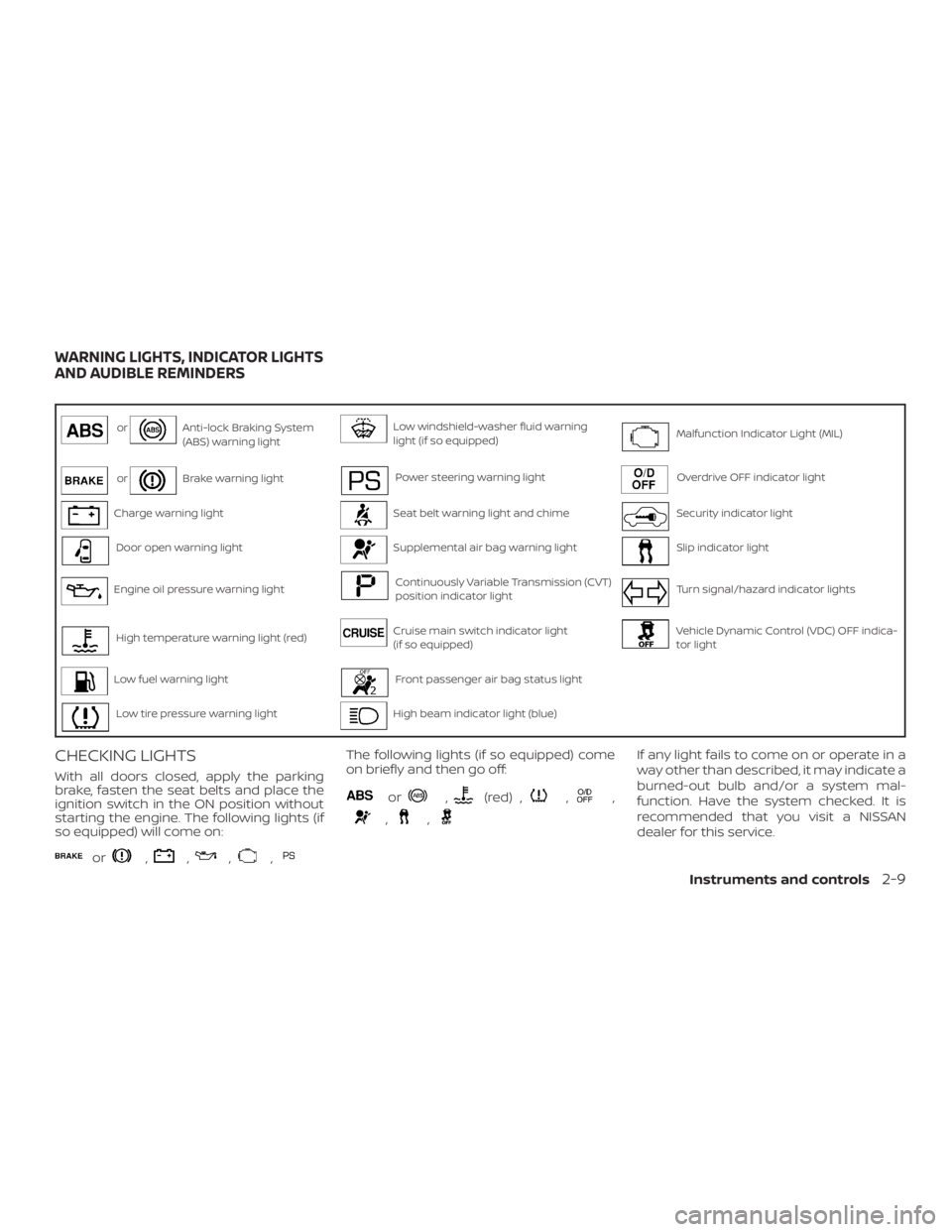Page 19 of 372
or
Anti-lock Braking
System (ABS)
warning light2-10
or
Brake warning
light2-10
Charge warning
light2-11
Door open warn-
ing light2-11
Engine oil pres-
sure warning light2-11
High temperature
warning light (red)2-11
Warning
lightName Page
Low fuel warning
light2-11
Low tire pressure
warning light2-12
Low windshield-
washer fluid
warning light (if so
equipped)2-13
Power steering
warning light2-13
Seat belt warning
light and chime2-14
Supplemental air
bag warning light2-14
Indicator
lightName Page
Continuously
Variable Trans-
mission (CVT) po-
sition indicator
light2-15
Cruise main
switch indicator
light (if so
equipped)2-15
Front passenger
air bag status
light2-15
High beam indi-
cator light (blue)2-15
Malfunction Indi-
cator Light (MIL)2-15
Overdrive OFF
indicator light2-16
WARNING AND INDICATOR LIGHTS
Illustrated table of contents0-9
Page 81 of 372

Anti-lock Braking System
(ABS) warning lightLow windshield-washer fluid warning
light (if so equipped)Malfunction Indicator Light (MIL)
orBrake warning lightPower steering warning lightOverdrive OFF indicator light
Charge warning lightSeat belt warning light and chimeSecurity indicator light
Door open warning lightSupplemental air bag warning lightSlip indicator light
Engine oil pressure warning lightContinuously Variable Transmission (CVT)
position indicator lightTurn signal/hazard indicator lights
High temperature warning light (red)Cruise main switch indicator light
(if so equipped)Vehicle Dynamic Control (VDC) OFF indica-
tor light
Low fuel warning lightFront passenger air bag status light
Low tire pressure warning lightHigh beam indicator light (blue)
CHECKING LIGHTS
With all doors closed, apply the parking
brake, fasten the seat belts and place the
ignition switch in the ON position without
starting the engine. The following lights (if
so equipped) will come on:
or,,,,
The following lights (if so equipped) come
on briefly and then go off:
or,(red) ,,,
,,
If any light fails to come on or operate in a
way other than described, it may indicate a
burned-out bulb and/or a system mal-
function. Have the system checked. It is
recommended that you visit a NISSAN
dealer for this service.
WARNING LIGHTS, INDICATOR LIGHTS
AND AUDIBLE REMINDERS
Instruments and controls2-9
Page 85 of 372
CAUTION
� The TPMS is not a substitute for the
regular tire pressure check. Be sure to
check the tire pressure regularly.
� If the vehicle is being driven at speeds
of less than 16 mph (25 km/h), the
TPMS may not operate correctly.
� Be sure to install the specified size of
tires to the four wheels correctly.
Power steering warning
light
Page 223 of 372
CAUTION
Do not place metalized film or any
metal parts (antenna, etc.) on the win-
dows. This may cause poor reception of
the signals from the tire pressure sen-
sors, and the TPMS will not function
properly.Some devices and transmitters may tem-
porarily interfere with the operation of the
TPMS and cause the low tire pressure
warning light to illuminate.
Some examples are:
∙ Facilities or electric devices using simi-
lar radio frequencies are near the ve-
hicle.
∙ If a transmitter set to similar frequen-
cies is being used in or near the vehicle.
∙ If a computer (or similar equipment) or
a DC/AC converter is being used in or
near the vehicle.
The low tire pressure warning light may
illuminate in the following cases:
∙ If the vehicle is equipped with a wheel
and tire without TPMS.
∙ If the TPMS has been replaced and the
ID has not been registered.
∙ If the wheel is not originally specified by
NISSAN.
Starting and driving5-5
Page 311 of 372
WARNING
� Improperly inflated tires can fail
suddenly and cause an
accident.� The Gross Vehicle Weight Rating
(GVWR) is located on the
F.M.V.S.S./C.M.V.S.S. certifica-
tion label. The vehicle weight
capacity is indicated on the Tire
and Loading Information label.
Do not load your vehicle beyond
this capacity. Overloading your
vehicle may result in reduced
tire life, unsafe operating condi-
tions due to premature tire fail-
ure, or unfavorable handling
characteristics and could also
lead to a serious accident. Load-
ing beyond the specified capac-
ity may also result in failure of
other vehicle components.
�
Before taking a long trip, or
whenever you heavily load your
vehicle, use a tire pressure gauge
to ensure that the tire pressures
are at the specified level.
� For additional information re-
garding tires, refer to
tant Tire Safety InformationŽ
(US) or Safety InformationŽ
(Canada) in the Warranty Infor-
mation Booklet.
Do-it-yourself8-33
Page 314 of 372
Size Cold Tire
Inflation
Pressure
Front Original Tire:
185/60R15C 94/92T44 psi
(300 kPa)
Rear Original Tire:
185/60R15C 94/92T48 psi
(325 kPa)
Spare Tire: Full size
TIRE LABELING
Federal law requires tire manufac-
turers to place standardized infor-
mation on the sidewall of all tires.
This information identifies and de-
scribes the fundamental character-
istics of the tire and also provides the
tire identification number (TIN) for
safety standard certification. The TIN
can be used to identif y the tire in
case of a recall.